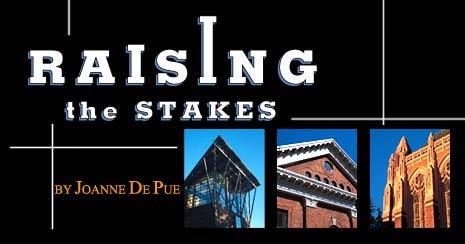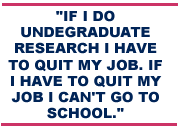

At UW Medicine, new buildings mean more lab space for researchers tackling some of society's most pressing health problems. Of the $1 billion UW Medicine seeks to raise over the course of Campaign UW, $60 million is earmarked for its South Lake Union campus, which will add nearly 800,000 square feet to UW Medicine's lab capacity.
Lynn Hogan, '69, executive director of development for UW Medicine, says the University's success in competing for federal research funds depends on more space. An infusion of private funding, she says, will enable the UW to continue its groundbreaking work in a variety of areas affecting health. For example, among the research projects to be housed at the South Lake Union campus are efforts to find a breast cancer vaccine and a push to combat heart attacks by growing new cardiac tissue.

UW Medicine's goals also include about $80 million for student support. "Our students graduate with an average of $80,000 debt and that is from medical school alone," Hogan says. "That debt often keeps students from making the career choice that they would really wish to make."
In addition to its aspirations for UW Medicine, the UW hopes to increase funding for graduate and professional student support. Graduate students are an asset to the classroom and the research enterprise. Often top faculty will not come to a university unless they know there are funds to support graduate students as well.
Whether it's support for undergraduates, graduate students, professors, new buildings or academic programs, the UW needs gifts of every size, says Kravas, who adds that the sum of generous donors at every level that will make or break the campaign. "It's the hardest thing to convey to donors, but it's so true that every gift of every size makes a difference," she says.
Walt Dryfoos, associate vice president of advancement services, points out that through June, 64,353 donors had given to the campaign at the level of less than $100. Those contributions totaled more than $2.3 million.
"Nobody would say that $2.3 million wasn't a major gift," he says. "It just took 63,713 people to make that major gift. That's why the smaller gifts are important. It's like former Senator William Proxmire said: 'A billion here, and a billion there, and pretty soon you're talking about real money.' Well, $25 here and $25 there, and pretty soon you're talking about real money in this context. We need all of those people."
The University will officially launch the public phase of its campaign at "Come Together Washington," a community celebration that starts at 6 p.m. Thursday, Oct. 15, in Hec Edmundson Pavilion. Microsoft Chairman Bill Gates is the keynote speaker and President Mark Emmert will make his first major address. For Mike McGavick, the event provides an opportunity to share with the public the incredible depth and breadth of the University's impact on the economy, global health, education, the environment, and the cultural fabric of our community.
"In all of those dimensions," he says, "the University of Washington is creating futures that are better for subsequent generations. And for our own."
If he set his time machine controls forward into the future, McGavick might see three thriving UW campuses. The central core of the Seattle campus would be preserved with its stunning Collegiate Gothic architecture, but surrounding it would be dramatic facilities for teaching and research. Both UW Bothell and UW Tacoma might have evolved into four-year universities serving thousands of students in spectacular buildings that enhance their unique environments.
Just as in the 20th century UW research perfected kidney dialysis and a vaccine for Hepatitis B, in this future world it might make a lasting contribution to global health through an AIDS vaccine or a cure for malaria. Just as UW researchers helped save Lake Washington from pollution in the 1960s, in the future it might preserve precious environments such as the Hood Canal or old growth forests.
Stepping out of his time machine, McGavick might be surprised at the economic spin-offs that came from UW research and teaching-just as today's leaders look back at how the UW aided both Boeing's and Microsoft's beginnings. The richness of the community's civic and cultural life would be even stronger thanks to the contributions of the University and its graduates.
Campaign UW, he says, is the next necessary step in the University's attempts to secure that brighter future.
—Joanne De Pue is a writer in UW Advancement Communications and the former editor of the Pike Place Market News.
Go To: Page 1 | Page 2
Sidebar - Campaign UW Unit Working Goals
Sidebar - Campaigns at Peer Institutions